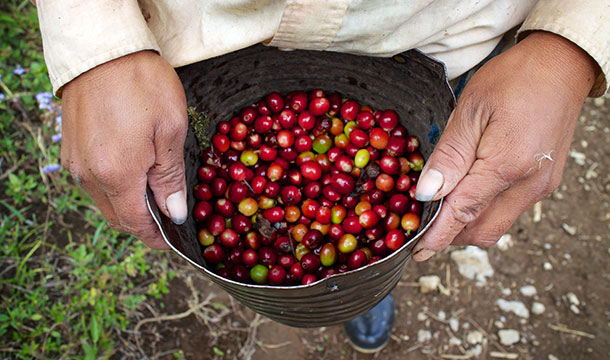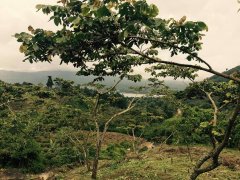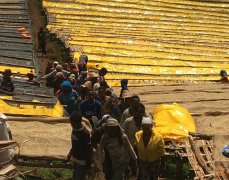Saint Vincent, the best coffee brand in Honduras, washes Honduran coffee beans.

For professional baristas, please follow the coffee workshop (Wechat official account cafe_style)
Product name: Saint Vincent treatment Plant, Honduras, Pacas + IH90 Variety washing
(Honduras San Vicente Edgardo Tinoco Pacas + IH90)
Producing area: Pena Blanca town, Santa Barbara (Santa Barbara)
Processing plant: St. Vincent treatment plant (Beneficio San Vicente)
Variety: Pacas + IH90 (one of the new varieties developed by the Honduran Coffee Association)
Grade: SHG
Altitude: 1300 to 1500 m
Certification: NCMA
Flavor features: almonds, cedar, dark chocolate, dark fruit,
Plum caramel, thick taste.

Introduction:
Coffee was grown in Honduras in 1804 and now has 280000 hectares of coffee plantations.
All of them are mainly small coffee farmers, and the planting area of their coffee plantations is mostly less than 3.5 hectares.
Coffee farmers account for 60% of Hongguo's coffee production. Coffee production in Honduras in 2011
Surpassed Guatemala and became the second largest exporter of washed Arabica beans in the world in 2012.
Second only to Brazil. It now ranks seventh in global production. Coffee cultivation is not like a banana garden.
Owned by two large American consortia and oligarchs, 92% of Honduran coffee farmers are small individuals.
Coffee-related workers account for 12.5% of the total population of 8 million, so coffee is in Honduras.
Is a very important crop. In the coffee garden, coffee farmers harvest red fruit, wash it, ferment it and add it.
To grade according to the needs of the market to meet the needs of different tastes of consumers. Honduras
3 million bags of coffee are harvested every year to provide good quality coffee and unique coffee flavor.
With a large quantity and excellent quality, it has become the largest producer in Central America and one of the top ten in the world.
Coffee exporter. The coffee industry in Honduras involves the livelihoods of hundreds of thousands of families across the country.
Provide one million jobs for important economic agriculture in Honduras.
Large coffee producing areas in Honduras, including Copan and Opalaca in western and southern areas.
, Montecillos, Comayagua, Agalta, El Paraico, etc.
The average planting height is above sea level. The variety of coffee is 100%
Arabica species, 69% belong to HG class, 12% are SHG,19% and CS. Mainly grow coffee
Varieties include Typica, Bourbon, Caturra, Villa Sarchi and Lempira.
Honduran coffee has always been of high quality, and its price is the most competitive in Central American countries.
Small, round, slightly bluish-green coffee, mild sour, full and slightly sweet
Suitable for both mixed coffee and single coffee, suitable for medium to deep roasting
Mainly exported to the United States, Germany and Japan. Honduras is already the first largest in Central America.
Coffee producing countries, whose output has been increasing in recent years, due to high international coffee prices in 2012.
The output of coffee in this year exceeded 5 million bags in 2010, with a great increase in production and continuous improvement in quality.
The largest coffee province in Honduras is the The Santa Barbara region, which is located in western Honduras.
Is in the northwest of Lake Yojoa, an area that has developed into Honduras in the past few years.
Famous coffee producing area. At the same time, this area comes from a famous agronomist Mr. Angel Arturo Paz
He owns a post-processing plant, St. Vincent's treatment Plant (San Vicente), in the western Yojoa Lake.
The small town of Pe ñ a Blanca in the northern Santa Barbara province (Santa Barbara)
He has always been the winner of the COE (Cup of Excellence) Cup in Honduras. St. Vincent treatment plant
Acquire the surrounding towns of El Cielito, Las Flores and El Cedral (these
Each place has at least 35 families and one school) coffee cherries produced by small coffee farmers.
Although the number is so small that it is usually difficult to separate these small farmers' output batches.
But the coffee produced in these regions has always been amazing with high sweetness and fruity.
St. Vincent (San Vicente) is a family-run processing plant that is well known locally.
As a result of assisting farmers to upgrade their planting technology and improve production equipment through projects, they are committed to investing in
The close contact of the producer, and take the coffee cup test as each batch of products strictly guarded.
This batch of St. Vincent treatment Plant Tropical Rainforest Certification SHG is a processing plant to acquire the surrounding area.
Small coffee farmers combine production and marketing, because the average planting area of each small coffee farmer is only
1Mel 2 hectares, the kilograms of raw beans for coffee production can not be sold independently, but can only be combined.
The whole batch of marketing together is a bit like a co-operative or a coffee production and marketing shift.
This batch of Saint Vincent (San Vicente) Ecuadorian small farmers (Edgardo Tinoco) is produced from
Edgardo Tinoco, a small village nearby, a collection of small coffee farmers, the planting area of general small farmers
Very small, can not handle the sale of raw beans alone, can only be sold to the processing plant concentrated quantity to sell together.
Flavor features: almonds, cedar, dark chocolate, dark fruit, plum caramel, thick taste.
Important Notice :
前街咖啡 FrontStreet Coffee has moved to new addredd:
FrontStreet Coffee Address: 315,Donghua East Road,GuangZhou
Tel:020 38364473
- Prev

Price of Honduran Highland Coffee selected batches of coffee beans by Honduran alpine coffee farmers
Exchange of professional baristas Please pay attention to the coffee workshop (Wechat official account cafe_style) small farmers' micro-batch coffee with small quantity and fine quality. The coffee industry in Honduras developed very early. More than a decade ago, it was only the positioning of non-characteristic commercial formula beans, dumping the market at large and low prices.
- Next

Honduran Coffee roasting Records Solar description of Honduran Coffee Tree Manor Coffee
Communication of professional baristas Please pay attention to the coffee workshop (Wechat official account cafe_style) Coffee flavor comes from various nutrients in raw coffee beans, which are thermally degraded into various odor molecular structures under roasting, producing flavors similar to various aromas. Good coffee beans are naturally rich in aroma, and there will be a variety of natural aroma changes at high, medium and low temperatures, which are very pleasant.
Related
- Does Rose Summer choose Blue, Green or Red? Detailed explanation of Rose Summer Coffee plots and Classification in Panamanian Jade Manor
- What is the difference between the origin, producing area, processing plant, cooperative and manor of coffee beans?
- How fine does the espresso powder fit? how to grind the espresso?
- Sca coffee roasting degree color card coffee roasting degree 8 roasting color values what do you mean?
- The practice of lattes: how to make lattes at home
- Introduction to Indonesian Fine Coffee beans-- Java Coffee producing area of Indonesian Arabica Coffee
- How much will the flavor of light and medium roasted rose summer be expressed? What baking level is rose summer suitable for?
- Introduction to the characteristics of washing, sun-drying or wet-planing coffee commonly used in Mantenin, Indonesia
- Price characteristics of Arabica Coffee Bean Starbucks introduction to Manning Coffee Bean Taste producing area Variety Manor
- What is the authentic Yega flavor? What are the flavor characteristics of the really excellent Yejasuffi coffee beans?

